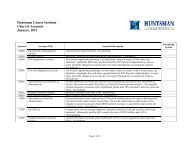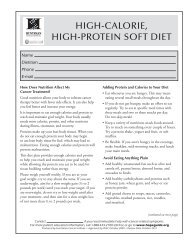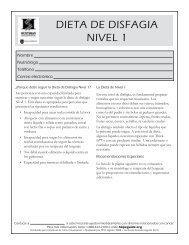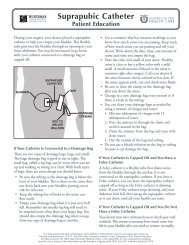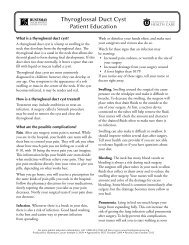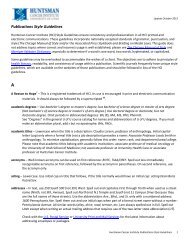Diabetes and Pancreatic Cancer Present ... - University of Utah
Diabetes and Pancreatic Cancer Present ... - University of Utah
Diabetes and Pancreatic Cancer Present ... - University of Utah
You also want an ePaper? Increase the reach of your titles
YUMPU automatically turns print PDFs into web optimized ePapers that Google loves.
<strong>Diabetes</strong> <strong>and</strong> <strong>Pancreatic</strong> <strong>Cancer</strong><strong>Present</strong> Interlocking Health Problems<strong>Pancreatic</strong> cancer <strong>and</strong> diabetes havea circular relationship. People withpancreatic cancer are at high riskfor developing diabetes. People withdiabetes are twice as likely as thosewho do not have the disease to developpancreatic cancer.<strong>Diabetes</strong> <strong>and</strong> the PancreasThe pancreas makes insulin, whichcontrols the way the body uses sugar.People with diabetes cannot use sugarproperly because they have too littleinsulin in the bloodstream.<strong>Pancreatic</strong> tumors may block insulinfrom entering the bloodstream, eventhough the pancreas still makes it.If surgery removes the tumor so theinsulin can be released properly, thediabetes will be cured.Some people develop diabetes because<strong>of</strong> their cancer treatment. Whenremoving the tumor also removes thepart <strong>of</strong> the pancreas that makes insulin,diabetes will occur.Having diabetes means that the bloodcontains too much glucose (also calledblood sugar). Glucose is the mainenergy source for cells in the body.However, too much blood sugar canlead to serious health problems.Eating Well with <strong>Diabetes</strong> <strong>and</strong> <strong>Cancer</strong>People with both diabetes <strong>and</strong> cancerhave special diet needs. A healthy dietis especially important for people withdiabetes. Making wise food choicescan help keep blood sugar levels closerto normal <strong>and</strong> improve overall health.Medicines <strong>and</strong> exercise also helpimprove healing, control weight, <strong>and</strong>increase quality <strong>of</strong> life.People with cancer <strong>and</strong> diabetes needto follow the advice <strong>of</strong> their healthcareteam. The Linda B. <strong>and</strong> RobertB. Wiggins Wellness Center <strong>of</strong>fersHuntsman <strong>Cancer</strong> Institute patients freeconsultations with a registered dietitian(RD). The dietitian can help coordinatemeal schedules with diabetes medicines.People with both diabetes <strong>and</strong> cancer havespecial diet needs. A healthy diet is especiallyimportant for people with diabetes.An RD can also design an eating planthat helps control blood sugar levels <strong>and</strong>cancer-related weight loss.To make an appointment with theWellness Center dietitian or RD, call801-587-4585.Clinical Trials UpdateClinical trials help doctors discoverthe best treatments possible. Patientsmay or may not directly benefit fromparticipating in a clinical trial. If youhave questions, please talk to yourdoctor for more information. At rightis a list <strong>of</strong> Pancreas <strong>Cancer</strong> ResearchProgram clinical trials currently open.A full list <strong>of</strong> Huntsman <strong>Cancer</strong> Instituteclinical trials is available atwww.huntsmancancer.org/clinicaltrials.IRB 36843 – Kimberly Jones, MDPhase III – Compares the effects<strong>of</strong> weekly doses <strong>of</strong> ABI-007 plusGemcitabine versus Gemcitabinealone in patients with metastaticadenocarcinoma <strong>of</strong> the pancreas.ABI-007 is approved for treatment<strong>of</strong> other recurring cancers, <strong>and</strong>Gemcitabine is known to be effectivein pancreatic cancer.Current <strong>and</strong> past issues <strong>of</strong> the Pancreas <strong>Cancer</strong> Research ProgramNewsletter can be viewed atwww.huntsmancancer.org/cancerInformation/newsletter— page 5 —
Food Choices Support Healthy Blood Sugar LevelsMany pancreas cancer patients havetrouble maintaining proper blood sugarlevels. (See article on page 5.) Here aresome tips for healthy eating:• Eat food from each <strong>of</strong> these five foodgroups at each meal every day:−−Fruits <strong>and</strong> vegetables−−Whole grains, cereals, <strong>and</strong> breads−−Dairy products−−Meat, fish, eggs, dried beans,<strong>and</strong> nuts−−Fats <strong>and</strong> oils• Eat meals <strong>and</strong> snacks at regular times.• Choose high-protein foods such asdried beans, peas, <strong>and</strong> lentils; leanmeats; <strong>and</strong> low-fat dairy products.• Choose high-fiber foods with complexcarbohydrates such as bran cereals,cooked beans <strong>and</strong> peas, whole-grainbread, fruits, <strong>and</strong> vegetables.• Choose small amounts <strong>of</strong> food withhealthy fat, including olives, avocados,nuts, seeds, <strong>and</strong> fish such as mackerel,lake trout, herring, sardines, albacoretuna, <strong>and</strong> salmon.• Cook with small amounts <strong>of</strong> healthyfats such as olive, canola, <strong>and</strong>peanut oils.If you have diabetes, be sure to followyour health-care team’s diet advice.Salads provide creative opportunities to addmore vegetables <strong>and</strong> fruits to a healthy diet.Huntsman <strong>Cancer</strong> Institute2000 Circle <strong>of</strong> Hope, Room 3130Salt Lake City, <strong>Utah</strong> 84112RETURN SERVICE REQUESTEDNONPROFIT ORGANIZATIONU.S. POSTAGEPAIDSALT LAKE CITY, UTAHPERMIT NO. 1529
23456Sunil Sharma, MD, Joins HCI<strong>Cancer</strong> Radiation Therapy Entersthe Fourth DimensionResearch Spotlight<strong>Diabetes</strong> <strong>and</strong> <strong>Pancreatic</strong> <strong>Cancer</strong> <strong>Present</strong>Interlocking Health ProblemsClinical Trials UpdateFood Choices Support HealthyBlood Sugar LevelsPancreas <strong>Cancer</strong> Research Programat Huntsman <strong>Cancer</strong> InstitutePANCREAS CANCER RESEARCH PROGRAM NEWSLETTER – FALL 2009Firsth<strong>and</strong> Account“I wake up every morning. That’s the absolute best thing,” says William Bowling,a patient at Huntsman <strong>Cancer</strong> Institute (HCI). He was diagnosed with pancreaticadenocarcinoma in June 2009. Although the seriousness <strong>of</strong> his disease is daunting,his voice sounds sure <strong>and</strong> strong.Until a few weeks ago, William owned a trucking company in Roosevelt, <strong>Utah</strong>,hauling water used in the drilling process to the oilfields. Since his cancerdiagnosis, William’s focus has shifted to his young family. He <strong>and</strong> his wifecelebrated their twentieth wedding anniversary on October 12. They have twodaughters <strong>and</strong> four sons between the ages <strong>of</strong> 14 <strong>and</strong> three.“I really strive to do things today,” says WilliamBowling, who was diagnosed with pancreaticcarcinoma in June 2009.William says that ending his habit <strong>of</strong>procrastination is the main change he’smade since his cancer diagnosis. “Nowinstead <strong>of</strong> saying ‘someday I ought to,’I really strive to do things today.”That includes spending time on thesoccer field. “We’re a soccer family. Wealways have been,” William says, <strong>and</strong>cancer isn’t changing that. Williamcoaches his 12-year-old son’s team,<strong>and</strong> his 14-year-old daughter coachesthe 7-year-old’s team.“The day I was diagnosed, we satdown together as a family to decidehow to face this,” William says. “Wecould spend our time moping <strong>and</strong>worrying, or we could live every daycontinued on page 2Mission StatementThe mission <strong>of</strong> the Pancreas <strong>Cancer</strong>Research Program (PCRP) atHuntsman <strong>Cancer</strong> Institute is toreduce suffering from pancreascancer <strong>and</strong> improve survival rates forpatients with the disease. Three goalsevolve from this mission: preventingpancreas cancer, detecting it early,<strong>and</strong> improving treatment options.The PCRP, a component <strong>of</strong> theGastrointestinal <strong>Cancer</strong> ResearchProgram, combines the expertise <strong>of</strong>specialized researchers <strong>and</strong> clinicianswith the resources <strong>of</strong> the <strong>Utah</strong>Population Database to identify<strong>and</strong> study genetic <strong>and</strong> other factorscontributing to pancreas cancer.HOW TO REACH USHereditary Gastrointestinal<strong>Cancer</strong> Registry801-585-19361-877-422-6860 toll freeGI <strong>Cancer</strong> Program801-587-44221-877-624-4422 toll freeHigh Risk Pancreas <strong>Cancer</strong> Clinic801-587-9555Pancreas <strong>Cancer</strong> Research Program801-585-60481-866-809-3799 toll freewww.huntsmancancer.org/gi
Firsth<strong>and</strong> Account(continued from page 1)Sunil Sharma, MD, Joins HCI asSenior Director <strong>of</strong> Clinical Researchwe have together to the fullest.All <strong>of</strong> us chose living to the full.”In hope <strong>of</strong> assuring many morefull days, William is participatingin an HCI clinical trial headedby Kimberly Jones, MD. Thetrial tests whether overall patientsurvival can be improved bycombining two drugs known tobe effective in pancreatic cancer,giving them at higher doses <strong>and</strong>on a different treatment schedulethan the FDA currently approves.William has advice for anyonefacing pancreatic cancer: “If thereis a clinical trial available to you,do it.”For up-to-date,accurate cancerinformation,visit theHOPE Guidewww.hopeguide.orgHuntsman <strong>Cancer</strong> Institute (HCI) isdeveloping a world-class program forthe study <strong>of</strong> new cancer therapies. TheCenter for Investigational Therapeutics(CIT) has two divisions—a researchbranch where scientists in the lab willstudy <strong>and</strong> develop new cancer therapies<strong>and</strong> a clinical branch where doctorsoversee the use <strong>of</strong> these new therapies ina Phase I clinical trials program.Phase I clinical trials are the initialhuman studies that test effectiveness<strong>and</strong> proper dosages for new treatments.Many st<strong>and</strong>ard cancer treatments usedtoday emerged from clinical trials.Phase I trials are <strong>of</strong>ten the best hopefor patients who are not responding tost<strong>and</strong>ard treatments.Sunil Sharma, MD, co-director <strong>of</strong> theCIT <strong>and</strong> senior director <strong>of</strong> clinical researchat HCI, joined HCI in July 2009. He is apr<strong>of</strong>essor in the Department <strong>of</strong> InternalMedicine at the <strong>University</strong> <strong>of</strong> <strong>Utah</strong>.“I am excited to bring a Phase I clinicaltrials program to the people <strong>of</strong> <strong>Utah</strong><strong>and</strong> the Intermountain West,” saysSharma. “It gives me a great sense <strong>of</strong>satisfaction to know how many peoplecould benefit from this program.”In the clinical setting, Sharma isinterested in the treatment <strong>of</strong> patientswith gastrointestinal (GI) cancers,mesothelioma (a form <strong>of</strong> cancer usuallylinked with asbestos exposure), <strong>and</strong>rare tumors. In the laboratory setting,he is internationally recognized in thearea <strong>of</strong> early-phase clinical trials <strong>and</strong>translational drug development.Sharma is an oncology consultant tomany leading pharmaceutical <strong>and</strong>Sunil Sharma, MDbiotechnology companies. He receivedhis medical oncology training at the<strong>University</strong> <strong>of</strong> Texas Health ScienceCenter, San Antonio, where hetrained with Daniel Von H<strong>of</strong>f, MD,a pioneer in the area <strong>of</strong> new cancerdrug development. At Memorial SloanKettering <strong>Cancer</strong> Center, he specializedin Phase I clinical trials <strong>and</strong> cared forpatients with GI cancers. He also took aleadership role at the drug developmentcompany Novartis Pharmaceuticals,responsible for the company’s early <strong>and</strong>translational drug portfolios. Beforejoining HCI, he set up a program inexperimental therapeutics with a largePhase I program at the Nevada <strong>Cancer</strong>Institute, Las Vegas.“Dr. Sharma is already having anincredible impact on advancing HCI’smission,” says Mary Beckerle, PhD,executive director <strong>of</strong> HCI. “He bringsto HCI a wealth <strong>of</strong> knowledge <strong>and</strong>experience, <strong>and</strong> his commitment tocollaborative science embodies the highestlevel <strong>of</strong> teamwork <strong>and</strong> scholarship.”New Blog Addresses GI <strong>Cancer</strong> IssuesKeep up on the latest news on research, wellness, <strong>and</strong> survivorship at the Gastrointestinal <strong>Cancer</strong>Program’s new blog. Recent entries include links to videos, healthy eating tips, <strong>and</strong> introductionsto staff members.To read the blog, go to www.hci.utah.edu/group/gi/program.jsp, scroll to the bottom <strong>of</strong> thepage <strong>and</strong> click the GI Blog banner.— page 2 —
Radiation Treatment for <strong>Cancer</strong> Enters the Fourth DimensionComputed tomography (CT) scan “movies” track tumormovement caused by breathing. A robotic couch preciselypositions the body with less than a millimeter <strong>of</strong> variation.<strong>Cancer</strong> radiation treatments may take days rather than weeks.These features describe the new image-guided radiationtherapy (IGRT) suite at Huntsman <strong>Cancer</strong> Hospital (HCH).The suite, in operation since August 2009, adds the latestcutting-edge technology. The equipment guides radiationtreatment precisely to the tumor <strong>and</strong> spares the surroundinghealthy tissues.Radiation therapy is <strong>of</strong>ten used to treat many cancers,including pancreatic cancer. It helps control the disease <strong>and</strong>improves patient survival. Radiation therapy works by causingdeadly damage to cancer cells. In normal cells, damage can bemore easily repaired by the body.At the beginning <strong>of</strong> the treatment planning process, a highspeedCT scanner takes several series <strong>of</strong> tumor images. At thesame time, a camera tracks the rise <strong>and</strong> fall <strong>of</strong> the patient’sbreathing. All these images are combined to produce a“movie” that shows how the tumor changes position duringeach breath. This adds the fourth dimension <strong>of</strong> time to theusual three-dimensional CT images. With informationfrom this scan, the radiation oncology team can design anindividual treatment plan for each patient. They can keep theradiation focused on the tumor <strong>and</strong> avoid damage to healthytissue in the area.The new IGRT suite includes the Artiste®, the latest radiationtreatment equipment from Siemens, a supplier <strong>of</strong> healthcaretechnology. HCH is one <strong>of</strong> the few cancer centersworldwide that has this treatment system. In this IGRT suite,a high-speed CT scanner in the same room allows preciseidentification <strong>of</strong> the target area. Another recent addition tothe IGRT suite includes a robotic couch for our Novalis®treatment system. This couch precisely positions a patientbased on X-ray images taken before treatment. Each <strong>of</strong> theseIGRT features allows treatment delivery accurate to less thana millimeter.Image-guided radiation therapy (IGRT) allows precise delivery <strong>of</strong>radiation to cancer while minimizing damage to surrounding healthytissue. Figure A shows a pancreatic tumor (pink) inside the high dosearea (red outline), <strong>and</strong> surrounding tissue where cancer is likely to havespread (turquoise) inside a lower dose area (yellow outline). Figure Bshows a stereotactic body radiation therapy (SBRT) plan where thehigh-dose radiation (red) is sharply focused on a liver tumor (orange).The rest <strong>of</strong> the liver (purple) receives a much lower dose (blue).HCI Radiation Oncology staff members Steve Meisner, ElaineR<strong>and</strong>olph, Diane Everett, <strong>and</strong> Troy Taylor operate the new IGRT suite.The suite includes the Siemens Artiste® <strong>and</strong> a high-speed CT scanner,which together allow state-<strong>of</strong>-the art image-guided stereotactic bodyradiation therapy (SBRT).Because these systems are so precise, sometimes radiationtherapy can be complete in just a few high-dose treatmentsover a few days. This is called stereotactic body radiationtherapy (SBRT). In pancreatic cancer, healthy-looking tissuenear the cancer could contain microscopic cancer cells. Thesetissues must be included in the treatment area. Then radiationmust be given over five to six weeks to reduce harm to healthytissue. The radiation oncologist consults with other members<strong>of</strong> the cancer care team to determine the appropriate radiationtherapy plan for each patient.These world-class technology advances <strong>and</strong> HCH’sexperienced team <strong>of</strong> pr<strong>of</strong>essionals make radiation treatment assafe <strong>and</strong> effective as possible for cancer patients.— page 3 —The Novalis®, HCI’s high-tech image-guided treatment unit capable <strong>of</strong>stereotactic body radiation therapy (SBRT). This instrument also allowsstereotactic radiosurgery, useful in treating tumors in surgically riskylocations. Radiation Oncology staff members Erin Schooler, DebbieWilson, <strong>and</strong> Brennen Esch operate the equipment.
Research SpotlightNew research <strong>of</strong>tenchallenges oldideas about disease.Charles Murtaugh,PhD a member <strong>of</strong>the Pancreas <strong>Cancer</strong>Research Program (PCRP), heads a labthat studies the origins <strong>of</strong> pancreascancer. Some <strong>of</strong> the lab’s findingshave overturned old assumptions.Scientists in the Murtaugh lab studythe process by which cells in thepancreas normally take on differentfunctional roles. This process iscalled cell differentiation. They alsoinvestigate what goes wrong whenpancreatic cancer develops.The pancreas contains severaldifferent types <strong>of</strong> cells:• Islet cells control blood sugar.• Acinar cells produce enzymes thathelp digest food.• Duct cells form a network thatchannels the enzymes intothe intestine.Under the microscope, pancreaticcancer cells look like duct cells.Because <strong>of</strong> this resemblance, manyscientists believed that the first steps<strong>of</strong> tumor formation occur induct cells.Researchers from the Murtaugh labsuggest a different possibility. Theirstudies have shown that pancreaticcancer can start from acinar cells inmice. They have also found that earlyin cancer development, acinar cellschange from their normal state tobecome more like duct cells.Reduce Risk—Quit SmokingDo you care about someone who smokes? Ask for HCI’sfree booklet “How to Help Your Loved One Stop UsingTobacco” available from the <strong>Cancer</strong> Learning Center.For more information, call the <strong>Cancer</strong> Learning Centerat 801-581-6365 or 1-888-424-2100 toll free.Currently, Murtaugh lab researchersare trying to underst<strong>and</strong> whatmakes this change in the acinar cellshappen. They study mice to findtreatments that keep the change fromoccurring. The researchers believethere is a strong chance that suchtreatments may prevent or reversepancreatic cancer. If the researchidentifies treatments that workin mice, then Huntsman <strong>Cancer</strong>Institute clinical trials could testthem in humans.In other studies, Murtaugh labresearchers found that mouse acinarcells become more prone to cancerwhen pancreatitis has injured thepancreas. This may also occurin humans. If so, it may explainthe connection between chronicpancreatitis <strong>and</strong> higher pancreaticcancer risk.The Murtaugh lab is studying miceto see whether drugs that inhibitpancreatitis also prevent pancreaticcancer. Again, if their research showsthat these drugs work in mice, HCIclinical trials can see if they work thesame way in human patients.They are conducting this study incollaboration with Matthew Firpo,PhD, research assistant pr<strong>of</strong>essor inthe Department <strong>of</strong> Surgery at the<strong>University</strong> <strong>of</strong> <strong>Utah</strong>. Firpo is an HCIinvestigator <strong>and</strong> a member <strong>of</strong> thePCRP.Murtaugh is an assistant pr<strong>of</strong>essor in theDepartment <strong>of</strong> Human Genetics at the<strong>University</strong> <strong>of</strong> <strong>Utah</strong> <strong>and</strong> a member <strong>of</strong> HCI’sGastrointestinal <strong>Cancer</strong>s Program.Help AdvancePancreas <strong>Cancer</strong>ResearchIndividuals in the community, <strong>of</strong>tenpatients diagnosed with pancreascancer <strong>and</strong> their family members,help provide funding for the Pancreas<strong>Cancer</strong> Research Program. Theprogram uses these donations to payresearch support staff, to obtain neededresearch equipment, <strong>and</strong> to fund pilotresearch projects. National researchorganizations usually support studiesonly after preliminary studies showthat a larger study could yield positiveresults. Internal funding for pilotstudies helps investigators perform thismuch-needed groundwork.If you would like to donate to cancerresearch, contact Huntsman <strong>Cancer</strong>Foundation at 801-584-5800 orwww.huntsmancancerfoundation.org.Wellness CenterPromotesBalanced CareThe Linda B. <strong>and</strong> Robert B. WigginsWellness Center <strong>of</strong>fers programs thataddress physical <strong>and</strong> emotional needs <strong>of</strong>patients <strong>and</strong> their families, including:• Fitness Program that providespersonalized exercise routines forcancer patients• Nutrition counseling with aregistered dietitian• Connections to support groups,workshops, <strong>and</strong> individual counseling• Bone health <strong>and</strong> osteoporosis program• Acupuncture for pain <strong>and</strong> nausea relief• Yoga classesFor more information about their services,call 801-587-4585 or visitwww. huntsmancancer.org/wellnesscenter— page 4 —




